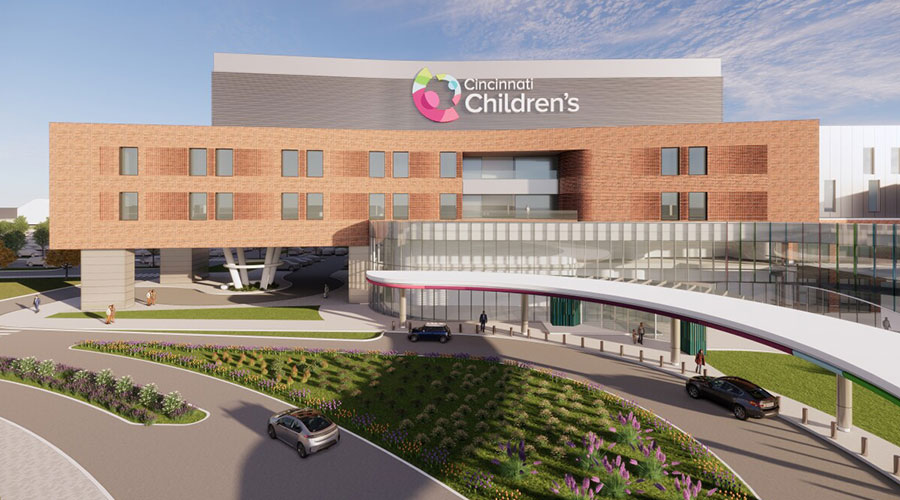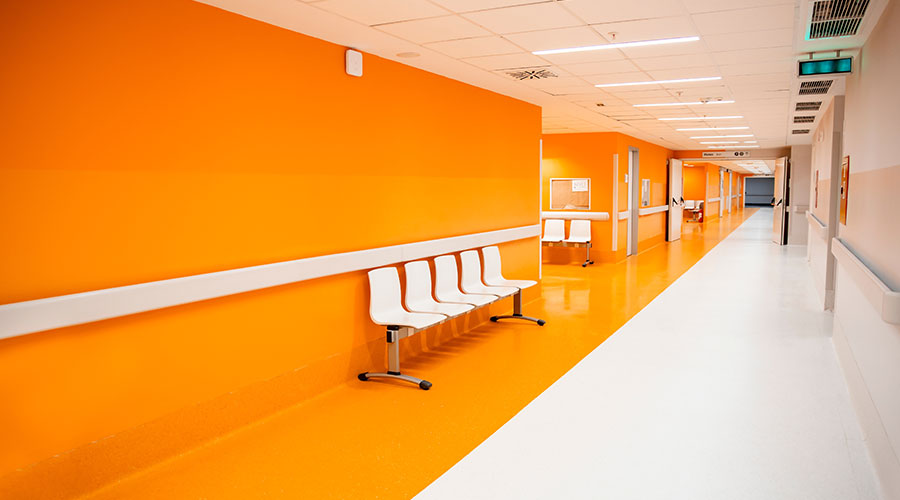As research continues to reveal the benefits of exposure to nature on the healing process and overall human well-being, architects and designers of healthcare facilities are prioritizing strategies that incorporate more gardens, outdoor restorative areas, skylights and natural material palettes into healthcare environments to create more holistic, therapeutic settings.
By transforming clinical spaces with organic elements and experiences, these design considerations can improve the outcomes of patients’ health and support the mental and emotional well-being of the staff that cares for them.
Integrating nature
Hospital lobbies and common areas should feel safe and welcoming and be conducive to healing and recovery. Design features such as skylights and biophilia introduce natural light, greenery and warmth for patients and their visitors.
Aquariums also offer multi-sensory touch points and have been shown to reduce anxiety, which is important to enhancing the hospital arrival experience. The tanks can also provide visual separation within common areas for greater privacy. By weaving in comfortable seating areas and artwork with natural textures and themes, design professionals are contributing to a holistic healing approach from the moment a patient walks into a facility.
Extending this authentic and immediate connection to nature is also crucial in patient rooms. Ensuring each room has a view of landscapes and greenery rather than neighboring buildings is a top priority. In urban settings where space is often limited and buildings are close together, architects and designers must employ creative solutions, such as integrating rooftop gardens and interior courtyards, to ensure patients and staff benefit from the natural elements to decompress despite spatial constraints.
These approaches raise aesthetic appeal and promote recovery by integrating biophilic design principles into densely populated and sometimes landlocked areas. For example, urban hospitals are exploring ways to leverage rooftops for gardens and carve out small spaces for interior and exterior courtyards to provide a therapeutic place in an urban setting for providers to unwind, meditate and relax while working.
In more suburban areas where finding space is less challenging, outdoor spaces allow patients to engage with nature more tangibly to support their healing. Walking paths through the medical campus, gardens with diverse plantings and sensory experiences that include different textures, smells and colors outdoors offer these opportunities and encourage physical movement.
While these areas are crucial for patient recovery, they also provide a space for staff to take a break and combat burnout. In long-term care facilities, natural grounds with accessible pathways for wheelchair access allow patients, visitors and staff to engage with the outdoors, fostering a calming environment that supports healing.
Enhancing comfort and personalizing patient rooms
Comfort is often personal, especially in healthcare settings. What works for one patient or ailment might not work for another, so designing for personalization in patient rooms is an equally important part of healing. One effective approach is equipping patient rooms with technology that accommodates their diverse needs or requests, including controls for lighting, heating and cooling.
In fact, many architects and designers have opted to integrate building management systems (BMS) into their designs, giving patients greater control over their room conditions. These systems allow for adjusting light intensity and color temperature throughout the day by tapping a tablet, which can help with decompression and sleep.
For instance, bright, cool-toned lighting can simulate daylight in the morning, helping regulate patients' circadian rhythms, while warmer, dimmed lighting in the evening promotes relaxation and prepares patients for rest. BMS technology also allows precise room temperature adjustments, further optimizing the healing environment based on individual preferences. Lowering the temperature at night supports better sleep quality and contributes to a rejuvenating space that fosters improved recovery outcomes.
Entertainment options are also important to consider, particularly in long-term care settings. New hospital patient room designs often include large screens with access to various streaming services. This allows patients to watch movies, listen to music, access information about their care team and medications, and review menu options that meet their dietary restrictions. These tailored touches, in conjunction with warm, earth-toned materials create a more home-like environment.
Acoustical properties in and around patient rooms are also being studied as a way to mitigate noise from adjacent nurse stations. This mitigation includes managing the bells, gongs and alarms that can disrupt patients while ensuring caregivers still receive the necessary auditory cues to address immediate care situations and life safety.
As healthcare design evolves, integrating nature and patient-centered elements is essential. Incorporating natural features such as natural light and greenery and prioritizing patient comfort through personalized rooms and thoughtful design creates environments that support healing, enhance patient comfort and contribute to a more positive experience for visitors and healthcare providers.
Al Thompson is managing executive at TPG Architecture.

 Power Reliability: NFPA Electrical Cycle of Safety
Power Reliability: NFPA Electrical Cycle of Safety Coos County Nursing Hospital Fighting Flu Outbreak
Coos County Nursing Hospital Fighting Flu Outbreak Cincinnati Children's Announces Expansion Project for Liberty Campus
Cincinnati Children's Announces Expansion Project for Liberty Campus Designing Safe and Supportive Senior Care Facilities for Veterans
Designing Safe and Supportive Senior Care Facilities for Veterans Ground Broken on AdventHealth Celebration New Patient Tower
Ground Broken on AdventHealth Celebration New Patient Tower